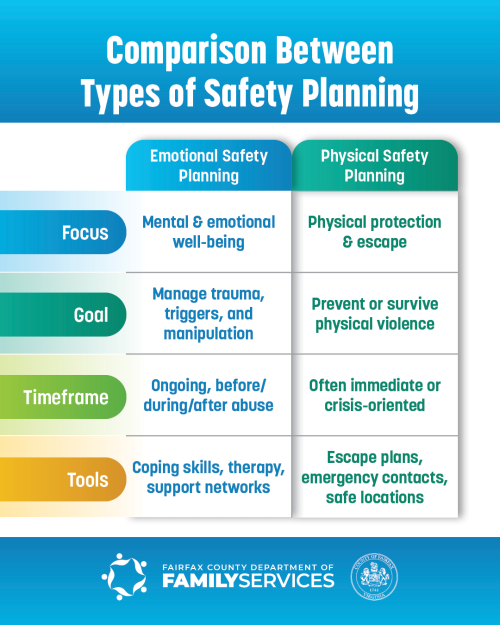(Posted 2025 November)
 We often emphasize physical safety, but do not consider a survivor’s emotional well-being when helping them create a safety plan. Of course, emotional safety looks different for different people, but planning for emotional safety is about developing a personalized plan that helps survivors feel comfortable about their emotions and decisions when dealing with abuse.
We often emphasize physical safety, but do not consider a survivor’s emotional well-being when helping them create a safety plan. Of course, emotional safety looks different for different people, but planning for emotional safety is about developing a personalized plan that helps survivors feel comfortable about their emotions and decisions when dealing with abuse.
Be clear: Both emotional and physical safety planning are essential and interconnected. But even after physical safety is secured, emotional wounds may linger. Survivors often say emotional safety planning helps them heal, rebuild trust, and regain independence long after the danger has passed.
Emotional safety planning focuses on helping a survivor protect and care for their mental and emotional well-being, both during and after an abusive or traumatic situation. It helps build resilience to help survivors deal with the impact of abuse, too. It’s about protecting the heart and mind, not just the body.
It’s about preparing ways to:
- Manage fear, anxiety, or trauma triggers
- Rebuild confidence and self-worth
- Cope with emotional manipulation or threats
- Stay connected to supportive people
- Regain a sense of control and calm
Examples of emotional safety strategies include:
- Identifying safe people to call or text when feeling afraid or overwhelmed
- Creating grounding techniques (like deep breathing, journaling, or sensory exercises) to use during flashbacks or panic
- Designing a physical, happy space to relax and work through the difficult emotions that arise when dealing with abuse (i.e., a room in the house, a pile of blankets in the closet, a comfy chair by a window, or a hammock in the backyard)
- Setting boundaries with those who cause emotional harm
- Preparing a support list of hotlines, therapists, or trusted friends
- Planning ways to remind oneself of strengths, goals, and inherent worth
Physical safety planning is about preventing or minimizing physical harm during or after violence. It includes concrete, logistical steps for survival and escape, should the victim choose to leave. It’s about protecting the body and ensuring immediate physical safety.
Examples of physical safety strategies include:
- Packing an emergency go-bag with keys, important documents, money, and medications
- Planning a safe exit route or a signal to alert neighbors
- Keeping a phone charged and knowing local shelters or police contacts
- Practicing how to get out safely with children or pets
- Changing locks, phone numbers, or routines after leaving
A good safety plan will have all the information a survivor needs to walk through scenarios they might come across while living with someone who is violent. Some things in an individual’s safety plan might seem obvious, and that’s OK. In a crisis, it can be hard to think clearly or make logical decisions about safety. Having a safety plan ahead of time can help protect in stressful moments.

Fairfax County’s Domestic and Sexual Violence Services division supports adults, teens, and children who have been impacted by domestic and sexual violence, stalking, and human trafficking. Services are confidential, free, and provided regardless of race, gender, ethnicity, national origin, age, disability, religion, gender identity, or sexual orientation.
If you or someone you know is experiencing interpersonal violence, call the Domestic and Sexual Violence 24-Hour Hotline at 703-360-7273 for resources and support. If you are in immediate danger, call 9-1-1.
This posting is part of the Department of Family Services' Community Corner where you’ll find timely information about upcoming events, parenting and wellness tips, programs and services, and more! Share these helpful posts with your friends and family. Don't miss out on future postings! Sign up today!

